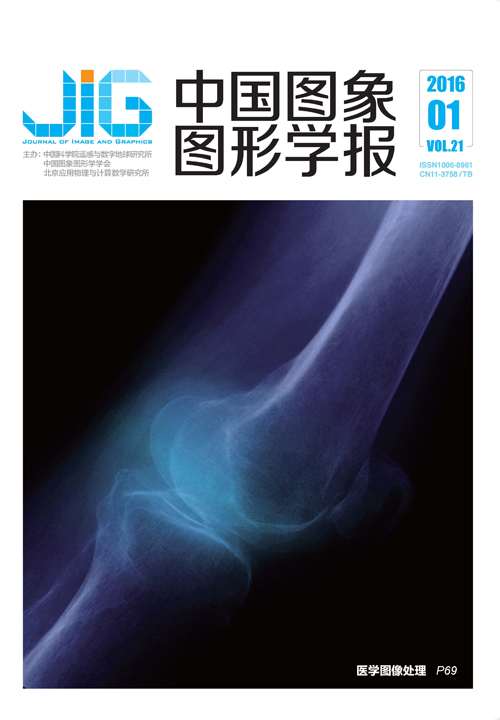
视差互信息引导下的立体航空影像与LiDAR点云自动配准
吴军1, 胡彦君1, 饶云1, 彭智勇1,2,3(1.桂林电子科技大学电子工程与自动化学院, 桂林 541004;2.广西信息科学实验中心, 桂林 541004;3.广西自动检测技术与仪器重点实验室, 桂林电子科技大学, 桂林 541004) 摘 要
目的 从视差图反映影像景物深度变化并与LiDAR系统距离量测信息"同源"这一认识出发,提出一种基于视差互信息的立体航空影像与LiDAR点云自动配准方法.方法 本文方法分为3个阶段:第一、通过半全局匹配SGM(semi-gdabal matching)生成立体航空影像密集视差图;第二、利用航空影像内参数及初始配准参数(外方位元素)对LiDAR点云进行"针孔"透视成像,生成与待配准的立体航空影像空间分辨率、几何形变相接近且具有相同幅面大小的模拟灰度影像-LiDAR深度影像,以互信息作为相似性测度依据估计航空影像视差图与LiDAR深度影像的几何映射关系,进而以之为基础实现LiDAR点云影像概略相关;第三、以LiDAR点云影像概略相关获得的近似同名像点为观测值,以视差互信息为权重,实施摄影测量空间后方交会计算获得优化的影像外方位元素,生成新的LiDAR深度影像并重复上述过程,直至满足给定的迭代计算条件.结果 选取重叠度约60%、幅面大小7 216×5 428像素、空间分辨率约0.5 m的立体航空像对与平均点间距约1.5 m、水平精度约25 cm的LiDAR"点云"进行空间配准实验,配准精度接近1个像素.结论 实验结果表明,本文方法自动化程度高且配准精度适中,理论上适用于不同场景类型、相机内参数已知立体航空影像,具有良好的应用价值.
关键词
Automatic registration of aerial stereo imagery to LiDAR data through iterative parallax mutual information computation
Wu Jun1, Hu Yanjun1, Rao Yun1, Peng Zhiyong1,2,3(1.School of Electrical Engineering and Automation Guilin University of Electronic Technology, Guilin 541004, China;2.Guangxi Experiment Center of Information Science, Guilin 541004, China;3.Guangxi Key Laboratory of Automatic Detecting Technology and Instruments, Guilin University of Electronic Technology, Guilin 541004, China) Abstract
Objective This paper presents our approach on registering aerial stereo imagery to LiDAR point cloud through iterative parallax mutual information computation.Method Proposed approach takes photogrammetry collinear equation as strict mathematic mode and three stages are involved: First, dense disparity map is generated from aerial stereo imagery using SGM algorithm; Second, LiDAR depth image with same size and approximate spatial resolution, geometrical distortion to the unregistered aerial image is generated, based on the perspective projection of LiDAR point cloud using initial image orientation parameters. In this step, supposed 2D rigid transformation between LiDAR depth image and the disparity map from aerial stereo imagery to be registered is estimated through maximizing their Mutual Information. As a result, by taking LiDAR depth image as a "bridge", visible LiDAR points are roughly mapped to aerial image pixels based on the estimated geometry transform parameters and the known projection relations between Lidar point clouds and its depth image. Third, with all mapped aerial image pixels as observed values and their parallax mutual information as weight, photogrammetry space resection algorithm is implemented to obtain improved image orientation parameters. Keeping repeating above two stages until the given iteration calculation condition is met and the registration of LiDAR point clouds with aerial stereo image is realized. Result Selected aerial stereo imagery with size 7 216×5 428 pixel, 60% overlap and spatial resolution 0.5 m are automatically geo-registered to LIDAR point cloud (averaged point distance 1.5 m, horizontal accuracy 25 cm) and approximate to 1 pixel registration precision is obtained. Conclusion The experimental results show that proposed algorithm has moderate registration precision and is in high degree of automation. Theoretically, with known interior of parameters (IOP) and initial exterior of parameters (EOP), proposed algorithm is suitable for various aerial stereo imagery taken for different types of scene and thus, has good value in application.
Keywords
|



 中国图象图形学报 │ 京ICP备05080539号-4 │ 本系统由
中国图象图形学报 │ 京ICP备05080539号-4 │ 本系统由